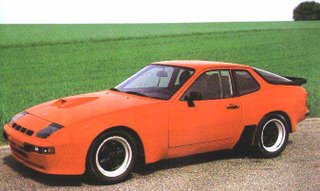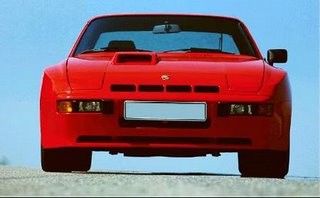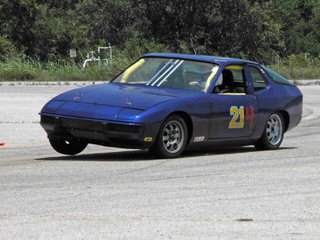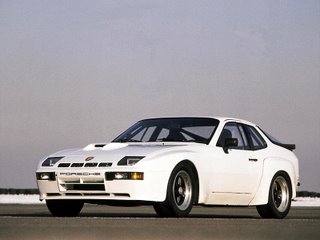




The Porsche 924 was an automobile produced by Porsche AG of Germany from 1976 to 1988. A two-door, 2+2 seat sports car coupe, the 924 replaced the 914 as the company's entry-level model, and was the model that finally retired the 912. It was the first Porsche model powered by a water-cooled, front-mounted engine to make production, although the similarly-configured 928 was designed before the 924. The front-engine, rear wheel drive arrangement was normal for most other manufacturers, but it was unusual for Porsche, who had previously only used mid or rear-mounted engines of a boxer configuration, all of which had been air-cooled. The 924 was a success, and not only helped to take Porsche out of financial ruin, but created the revenue stream needed to continue building and developing the 911. The 924 was replaced by the 944 in 1982 in the US market, but continued to be produced until 1985 in the Rest of World market.
The 924 was originally intended to be Volkswagen's flagship sports coupe. Volkswagen commissioned Porsche to design the car, who developed a fresh chassis and transmission that would work with an existing Audi I4 engine. They also handled the suspension and the interior and exterior design. Porsche decided on a rear wheel drive layout, and designed a rear transaxle to help provide 52/48 front/rear weight distribution.
Due to growing concern over the oil crisis, Volkswagen put the project on hold, eventually dumping it entirely after their decision to move forward with the Quattro Coupe model instead. Porsche, who needed a model to replace the 914, made a deal with Volkswagen leadership, agreeing to buy the design for 100 million DM -- $10 million less than what Volkswagen paid Porsche to design it.
The deal specified that the car would be built at the ex-NSU factory in Neckarsulm located north of the Porsche headquarters in Stuttgart, the Volkswagen employees would do the actual production line work and that Porsche would own the design. It became one of Porsche's best-selling models to date, and the relative cheapness of building the car made it both profitable and fairly easy for Porsche to finance.
The original design used an Audi-sourced four-speed manual transmission for the 924 mated to VW's EA831 2.0 L I4 engine, previously used in the Audi 100 and Volkswagen LT van and producing 95 hp (71 kW) in North American trim. This later came up to 110hp (87kw). The four-speed manual was the only transmission available for the initial 1976 model. An Audi three speed automatic was offered starting with the 1977 model year.
European models, which didn't require power-sapping emissions equipment, made 125 hp. They also differed visually from the US spec model by not having the US cars low-speed impact bumpers and the round reflectors on each end of the body.
A 5-speed transmission, available starting in 1979, was a "dogleg" Porsche unit. This was troublesome and was quickly replaced for 1980 with a normal H-pattern audi five speed. The brakes were solid discs at the front and drums at the rear. The four wheel disc brakes, five lug hubs and alloys from the 924 Turbo were available on the base 924 as an "S" package starting with the 1980 model year.
The overall styling was penned by Dutchman Harm Lagaay, a member of the Porsche styling team, with the hidden headlights, sloping hoodline and grille-less nose giving the car its popular wedge shape. The car went on sale in the USA in July 1976 as a 1977 model with a base price of $9,395. Porsche made small improvements to the 924 each model year between 1977 and 1985, but nothing major was changed.
The 924 was originally intended to be Volkswagen's flagship sports coupe. Volkswagen commissioned Porsche to design the car, who developed a fresh chassis and transmission that would work with an existing Audi I4 engine. They also handled the suspension and the interior and exterior design. Porsche decided on a rear wheel drive layout, and designed a rear transaxle to help provide 52/48 front/rear weight distribution.
Due to growing concern over the oil crisis, Volkswagen put the project on hold, eventually dumping it entirely after their decision to move forward with the Quattro Coupe model instead. Porsche, who needed a model to replace the 914, made a deal with Volkswagen leadership, agreeing to buy the design for 100 million DM -- $10 million less than what Volkswagen paid Porsche to design it.
The deal specified that the car would be built at the ex-NSU factory in Neckarsulm located north of the Porsche headquarters in Stuttgart, the Volkswagen employees would do the actual production line work and that Porsche would own the design. It became one of Porsche's best-selling models to date, and the relative cheapness of building the car made it both profitable and fairly easy for Porsche to finance.
The original design used an Audi-sourced four-speed manual transmission for the 924 mated to VW's EA831 2.0 L I4 engine, previously used in the Audi 100 and Volkswagen LT van and producing 95 hp (71 kW) in North American trim. This later came up to 110hp (87kw). The four-speed manual was the only transmission available for the initial 1976 model. An Audi three speed automatic was offered starting with the 1977 model year.
European models, which didn't require power-sapping emissions equipment, made 125 hp. They also differed visually from the US spec model by not having the US cars low-speed impact bumpers and the round reflectors on each end of the body.
A 5-speed transmission, available starting in 1979, was a "dogleg" Porsche unit. This was troublesome and was quickly replaced for 1980 with a normal H-pattern audi five speed. The brakes were solid discs at the front and drums at the rear. The four wheel disc brakes, five lug hubs and alloys from the 924 Turbo were available on the base 924 as an "S" package starting with the 1980 model year.
The overall styling was penned by Dutchman Harm Lagaay, a member of the Porsche styling team, with the hidden headlights, sloping hoodline and grille-less nose giving the car its popular wedge shape. The car went on sale in the USA in July 1976 as a 1977 model with a base price of $9,395. Porsche made small improvements to the 924 each model year between 1977 and 1985, but nothing major was changed.





No comments:
Post a Comment